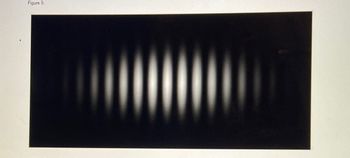
College Physics
11th Edition
ISBN: 9781305952300
Author: Raymond A. Serway, Chris Vuille
Publisher: Cengage Learning
expand_more
expand_more
format_list_bulleted
Concept explainers
Question

Transcribed Image Text:Please refer to Figure 3, which shows the pattern of interference fringes for light of wavelength 695 nm passing through two narrow slits,
projected onto a screen a distance of 2.28 m away. The distance on the screen between the centers of two adjacent bright fringes is 1.94 cm
What is the distance between the two slits?
6.54E-05 m
8.17E-05 m
1.47E-04 m
O 1.06E-04 m

Transcribed Image Text:Figure 3:
Expert Solution
This question has been solved!
Explore an expertly crafted, step-by-step solution for a thorough understanding of key concepts.
Step by stepSolved in 2 steps with 2 images

Knowledge Booster
Learn more about
Need a deep-dive on the concept behind this application? Look no further. Learn more about this topic, physics and related others by exploring similar questions and additional content below.Similar questions
- Light of wavelength 632 nm passes through a slit 7.00 × 106 m wide and falls on a screen that is 2.19 m away. What is the distance on the screen from the center of the central bright fringe to the third dark fringe on either side? Number i 0.5 Units marrow_forwardCalculate the distance between two adjacent bright fringes for coherent light of wavelength 488 nm passing through double slits separated by 0.05 mm. The slits are located 2.00 m from a screen. Central maximum 2.60 cm O 1.22 cm 1.75 cm 2.37 cm O 1.95 cmarrow_forwardThe third dark fringe in a single slit experiment occurs at an angle of 15 degrees. What is the width of the slit if the light used has a wavelength of 630 nm? Draw a picturearrow_forward
- 10. Please refer to Figure 3, which shows the pattern of interference fringes for light of wavelength 505 nm passing through two narrow slits, projected onto a screen a distance of 2.06 m away. The distance on the screen between the centers of two adjacent bright fringes is 1.18 cm. What is the distance between the two slits? 1.50E-04 m 1.15E-04 m 5.29E-05 m 8.82E-05 marrow_forwarda. Light with a wavelength of 550 nm is incident upon a double slit with a separation of 0.3 mm (3×10–4 m). A screen is located 1.5 m from the double slit. At what distance from the center of the screen will the first bright fringe beyond the center fringe appear? The first bright fringe will appear __ cm beyond the center fringe.b b. Light with a wavelength of 510 nm is incident upon a double slit with a separation of 0.3 mm (0.3×10–3 m). A screen is located 1.5 m from the double slit. At what distance from the center of the screen will the fourth dark fringe appear? The fourth dark fringe will appear at a distance of __mm.arrow_forwardA blue light of 450 nm passes through a single slit and the first dark bands on either side of the center are separated by 53.0°. What is the width of the slit?arrow_forward
- The spacing between two slits is 5.90×10^-3 m in a Young's double slit experiment. The distance from the slits to the screen is 1.00 m, and the distance from the central bright maximum to the third maxima is 2.50x10^-4 m. Determine the wavelength of the incident light used in the experiment. Include a labelled diagram.arrow_forwardEM WAVES HAVING A WAVELENGTH OF λ = 480nm A PASS THROUGH A SINGLE SLIT AND PRODUCE THE PATTERN SHOWN AT RIGHT ON A SCREEN 0.60m BEYOND. THE DISTANCE FROM A To B IS 0.15m. FIND THE WIDTH, W, OF THE SINGLE SLIT. T BRIGHT II T 8arrow_forwardplease answer varrow_forward
- Answer for B onlyarrow_forwardIn the figure, a broad beam of light of wavelength 660 nm is sent directly downward through the top plate of a pair of glass Link 2 5. The plates are 120 mm long, touch at the left end, and are separated by 69 um at the right end. The air between the plates acts as a thin film. How many bright fringes will be seen by an observer looking down through the top plate? Incident light Number Unitsarrow_forwardA laser beam is normally incident on a single slit with width 0.620 mm. A diffraction pattern forms on a screen a distance 1.35 m beyond the slit. The distance between the positions of zero intensity on both sides of the central maximum is 2.18 mm. Calculate the wavelength of the light (in nm). nm Need Help? Read Itarrow_forward
arrow_back_ios
SEE MORE QUESTIONS
arrow_forward_ios
Recommended textbooks for you
 College PhysicsPhysicsISBN:9781305952300Author:Raymond A. Serway, Chris VuillePublisher:Cengage Learning
College PhysicsPhysicsISBN:9781305952300Author:Raymond A. Serway, Chris VuillePublisher:Cengage Learning University Physics (14th Edition)PhysicsISBN:9780133969290Author:Hugh D. Young, Roger A. FreedmanPublisher:PEARSON
University Physics (14th Edition)PhysicsISBN:9780133969290Author:Hugh D. Young, Roger A. FreedmanPublisher:PEARSON Introduction To Quantum MechanicsPhysicsISBN:9781107189638Author:Griffiths, David J., Schroeter, Darrell F.Publisher:Cambridge University Press
Introduction To Quantum MechanicsPhysicsISBN:9781107189638Author:Griffiths, David J., Schroeter, Darrell F.Publisher:Cambridge University Press Physics for Scientists and EngineersPhysicsISBN:9781337553278Author:Raymond A. Serway, John W. JewettPublisher:Cengage Learning
Physics for Scientists and EngineersPhysicsISBN:9781337553278Author:Raymond A. Serway, John W. JewettPublisher:Cengage Learning Lecture- Tutorials for Introductory AstronomyPhysicsISBN:9780321820464Author:Edward E. Prather, Tim P. Slater, Jeff P. Adams, Gina BrissendenPublisher:Addison-Wesley
Lecture- Tutorials for Introductory AstronomyPhysicsISBN:9780321820464Author:Edward E. Prather, Tim P. Slater, Jeff P. Adams, Gina BrissendenPublisher:Addison-Wesley College Physics: A Strategic Approach (4th Editio...PhysicsISBN:9780134609034Author:Randall D. Knight (Professor Emeritus), Brian Jones, Stuart FieldPublisher:PEARSON
College Physics: A Strategic Approach (4th Editio...PhysicsISBN:9780134609034Author:Randall D. Knight (Professor Emeritus), Brian Jones, Stuart FieldPublisher:PEARSON

College Physics
Physics
ISBN:9781305952300
Author:Raymond A. Serway, Chris Vuille
Publisher:Cengage Learning

University Physics (14th Edition)
Physics
ISBN:9780133969290
Author:Hugh D. Young, Roger A. Freedman
Publisher:PEARSON

Introduction To Quantum Mechanics
Physics
ISBN:9781107189638
Author:Griffiths, David J., Schroeter, Darrell F.
Publisher:Cambridge University Press

Physics for Scientists and Engineers
Physics
ISBN:9781337553278
Author:Raymond A. Serway, John W. Jewett
Publisher:Cengage Learning

Lecture- Tutorials for Introductory Astronomy
Physics
ISBN:9780321820464
Author:Edward E. Prather, Tim P. Slater, Jeff P. Adams, Gina Brissenden
Publisher:Addison-Wesley

College Physics: A Strategic Approach (4th Editio...
Physics
ISBN:9780134609034
Author:Randall D. Knight (Professor Emeritus), Brian Jones, Stuart Field
Publisher:PEARSON